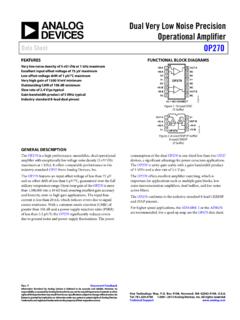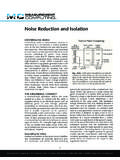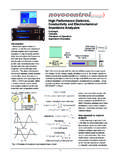Transcription of REITBARTH AND - Holzworth
1 RESIDUAL OR ADDITIVE PHASE NOISEMEASUREMENT FUNDAMENTALSA dditive phase noise , also referred to asresidual phase noise , is the self phase noise ofa component that adds to an existing signal asthe signal passes through it. It is additive lin-early, not in decibels, which would be multi-plicative. The term residual phase noise isused interchangeably with additive phasenoise and is in reference to the original phasenoise measurement of components. The mea-surement system inherently subtracts out thesource noise in the test system, which leavesthe phase noise of the DUT, or residual phasenoise, as the remainder of what is being mea-sured.
2 Additive phase noise is a more apt de-scription of the noise within the system beingused, rather than reference to the measure-ment ANDJOEKOEBELH olzworth InstrumentationBoulder, COPhase noise is becoming generally recog-nized (and accepted) as a critical perfor-mance parameter in higher performingtest, radar and communication systems. How-ever, additive phase noise is not typically mea-sured on amplifiers, frequency dividers or fre-quency multipliers due to the perceived diffi-culty of the measurement and the prohibitivecost of available phase noise measurement to popular belief, accurate addi-tive phase noise measurements are straight-forward.
3 Phase noise is typically considered anesoteric measurement, which many engineersand technicians would rather not have tomake. This article removes the mystery fromadditive phase noise measurements and sim-plifies some of the techniques. Some knowl-edge of trigonometry is all that is really need-ed to understand additive phase noise mea-surements. This article demonstrates how tomake valid residual phase noise measurementswith a good synthesizer, low noise basebandamplifier and an audio (RESIDUAL) PHASENOISEMEASUREMENTOFAMPLIFIERS, FREQUENCYDIVIDERSANDFREQUENCYMULTIPLIERS R eprinted with permission of MICROWAVE JOURNAL from the June 2008 issue.
4 2008 Horizon House Publications, Inc. Why is additive phase noise im-portant? Following are two examples,the first being the most OneConsider a system that begins witha very low noise oven-controlled crys-tal oscillator (OCXO). A significantamount of work is done by the manu-facturer to select appropriate internalcomponents that add very little flickernoise to the signal. GaAs amplifierstend to have a high flicker noise cor-ner, a property on all amplifiers, thando silicon-based amplifiers. If a GaAsamplifier is used to amplify a veryclean OCXO, it will likely degrade thephase noise in the 10 kHz region andpossibly further out, depending on thesignal-to- noise ratio of the amplifieroperating under large signal.
5 Equation1 shows mathematically how the phasenoise of the OCXO and amplifier , indBc/Hz, add together+++fm systemfm OCXOfm AMP=+ 101010101010log ()1 Figure 1is a graphical representa-tion of Equation 1, where combiningthe noise of a good OCXO (in blue)and that of a marginal amplifier (inred) will cause degradations in theoverall phase noise of the system (inblack). At the point where the phasenoises of the OCXO and amplifiersare equal and identical, at kHz,the overall noise is exactly 3 dB 2 This example is less obvious. Mostwill agree that noise figure (besidesgain and P 1dB) is one of the mostcommon specifications for an amplifi-er.
6 This number does not fully repre-sent the true added noise of an am-plifier under anything but small-sig-nal conditions and is an average fornoise in carrier offset frequencieswithin a 4 MHz bandwidth. If onewants to measure the added noise ofan amplifier when it is near compres-sion, deep in compression, or whenusing a noisy power supply, the noisefigure will not disclose any informa-tion that is useful under these scenar-ios. Additionally, the noise figuredoes not disclose any informationabout noise close to the carrier thatmay be important in some system. Itcan also be argued that additivephase noise measurements are in-deed a good measurement for large-signal noise PHASE noise RELATEDTO noise FIGUREA dditive phase noise is directly re-lated to noise figure under small-sig-nal conditions.
7 Under large-signalconditions, additive phase noise mayaptly define large-signal noise traditional noise figure is an av-erage of the additive phase noise un-der a very particular small-signal con-dition. noise figure is defined as thedegradation of the signal-to- noise ra-tio (SNR) at the input to the SNR atthe output of a two-port device. Alow noise amplifier may add less than1 dB in a typical noise figure mea-surement and a standard gain blockmay exhibit over 5 dB. When takenout of small signal, but with an outputpower still near the P 1dBpoint, otheraspects of the amplifier start to be-come dominant and the noise figuremeasurement may no longer be noise , shot noise and powersupply noise may contribute a moresignificant amount of noise to the sys-tem than the noise figure may sug-gest.
8 Some amplifiers exhibit margin-ally more noise in compression thanat small signal, while others willdemonstrate heavy an additive phase noise mea-surement can identify these sourcesof figure and phase noise mea-surements (at relatively small signal)relate to each other in the followingway: The measured additive phasenoise, +fmof an amplifier at someoffset frequency (fm), is related tothe noise figure by the thermal noisefloor (Nthermal) and the amount of in-put power (Pin). This relationship hasbeen presented by A. Hati, et thermal noise floor of a 50 system, denoted as Nthermal, at roomtemperature, is 174 dBm, which in-cludes both amplitude and phasenoise.
9 Amplitude and phase noiseeach contribute to half the power ofthe thermal noise and are assumed tobe uncorrelated, therefore leavingboth the phase and amplitude of thethermal noise floor to be separatelydefined at 177 dBm. The value forNthermalis then 177 SNR of a signal is defined asNthermal Pin, where Pinis the signalpower in dBm. The noise figure (NF)is the reduction of the signal-to-noiseratio of a two-port device. The mea-sured phase noise is related to thethermal noise floor, input power andnoise figure by the following relation:where+fm=measured additive phasenoise at frequency offset fmNthermal=thermal noise floor ( 177 dBm)Pin=input power of the amplifierNF= noise figure of the amplifierThis equation shows that the sig-nal-to- noise ratio (Nthermal Pin) isreduced by the noise figure resultingin the measured additive phase equation can be used to calcu-late the noise figure, given the mea-sured additive phase noise and powerinput.
10 The additive phase noise mea-surement can be used to calculate thenoise figure of a device within the un-certainty of the measurement. More+fmthermalinNPNF=+ ()2 TECHNICALFEATURE 110 120 130 140 150 160 170 180 SINGLE SIDEBANDPHASE noise (dBc/Hz)SYSTEM PHASE NOISEOCXO PHASE NOISEAMP ADDITIVE PHASE NOISE106105104 FREQUENCY OFFSET (Hz)103102sFig. 1 Graphical representation of theadditive phase noise of an amplifier . 110 120 130 140 150 160 170 180 SINGLE SIDEBANDPHASE noise (dBc/Hz)MEASUREMENTNOISE FLOORAMPLIFIER,PIN = 15 dBm 158 dBc/Hz104103 FREQUENCY OFFSET (Hz)102101sFig. 2 Measured additive phase noise ofan amplifier with Pin= 15 , the additive phase noisemeasurement can give meaningfuldata on the true signal-to- noise ratiofor an amplifier at large signal underreal world 2is an example of an addi-tive phase noise measurement at acarrier of 100 MHz.







